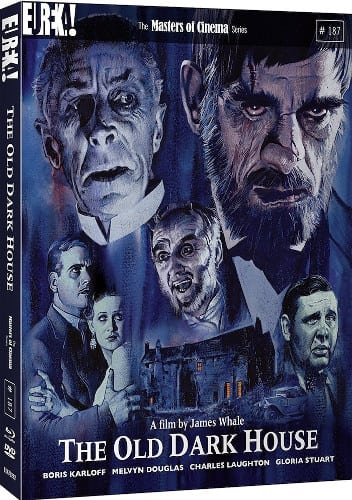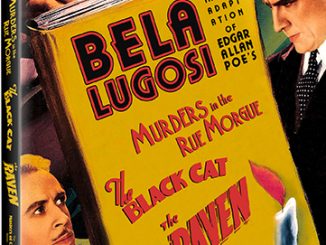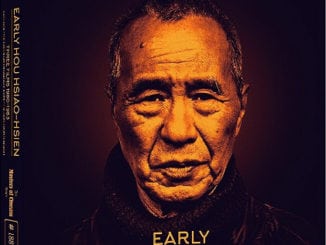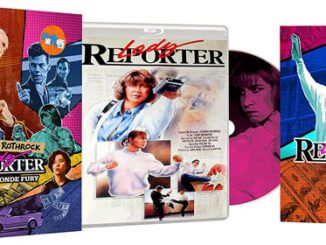The Old Dark House (1932)
Directed by: James Whale
Written by: Benn W. Levy, J.B. Priestley, R.C. Sherriff
Starring: Boris Karloff, Charles Laughton, Ernest Thesiger, Melvyn Douglas
USA
AVAILABLE ON DUAL FORMAT BLU-RAY AND DVD: 21ST from EUREKA ENTERTAINMENT
RUNNING TIME: 72 mins
REVIEWED BY: Dr Lenera, Official HCF Critic
On a stormy night in Wales, Philip and Margaret Waverton and their friend Penderel seek refuge in a gloomy house off the road after a landslide during a rainstorm. The denizens of the house appear to be Horace Femm a hysteric, his sister Rebecca a religious fanatic, and Morgan their mute, scarred and brutish butler. At dinner, Horace confides that sometime in the past, their sister Rachel died in a mysterious fashion. Then two more people seek shelter – William Porterhouse and his companion Gladys Perkins. As the evening progresses, it becomes apparent that there are could be two more strange inhabitants of the house – somebody who lives at the very top floor, and someone called Saul….
The four horror films that James Whale made from 1931 to 1935 are all absolute classics of the genre, even if truth be told three of them are as much comedy as horror, with Whale usually more interested in making a parody than a serious film. It’s sometimes said that he was never especially interested in horror, which is why his three chillers after the almost entirely serious Frankenstein are so humorous, the films often mocking horror cliches as they invent a whole load of new ones [one example of their genius]. Bride Of Frankenstein is usually held up as the craziest of the four, but in a way it’s The Old Dark House which is the oddest. It may not have the constant level of madness of the 1935 film [one of my personal favourite films of all time], but there’s still something incredibly peculiar about it in a way that’s hard to describe, like it’s been directed by somebody whose brain works in a very different way to ours. I never got to see it till quite a while after the others because it wasn’t usually included in seasons of the Universal horrors when shown on TV. Very much like a stage play with most of its running time packed with dialogue, it may disappoint those looking for lots of Gothic chills and does seem to stop as soon as it really gets going, but it’s pretty funny [as soon as you appreciate drier-than-dry humour of course] and positively reeking of gloomy Gothic atmosphere. I wasn’t a big fan at first, but it’s the kind of film that may grow on you, and watching Eureka’s absolutely astonishing Blu-ray restoration of the film made me realise that now I pretty much love the thing and welcome this opportunity to heavily revise and expand an old review of mine.
It was based on the 1927 novel Benighted by J. B. Priestley, published in the United States under the same title as the film, and was adapted for the screen by Benn Levy and an uncredited R. C. Sherriff who rewrote much of the dialogue. The book was serious and highly symbolic, with the odd inhabitants of the house representing various forms of post-First World War pessimism. The comedy was nearly all added but much of the book’s dialogue remained. After the success of Frankenstein, Whale was pretty much given carte blanche to make whatever he wanted, especially if Boris Karloff was on board, and was able to hold off Universal’s nagging for a Frankenstein sequel for a while. Gloria Stuart recalled that Charles Laughton ran back and forth across the stage to achieve the desired effect of being out of breath. She asked him, “Can’t you just fake it?” and he said that wasn’t the way he worked. She and Melvyn Douglas were decidedly outnumbered and felt like outcasts as the English cast never once asked them to join them for their tea breaks. The ambiguity surrounding the survival of one character had to be replaced by certainly that this person survived at the behest of Universal. The Old Dark House was largely ignored at the American box office but was a huge hit in the UK and led to the somewhat similar The Ghoul, which would also star Thesiger and the extremely busy Karloff. For some reason Universal lost the rights to the film in 1957, then in 1963 a mediocre remake from Hammer and William Castle saw it withdrawn from circulation until a print was discovered in 1967 by Whale’s fellow director and friend Curtis Harrington after much searching. Sadly it was of poor quality, so only recently has the film has never undergone the restoration many of the other Universal horror films have.
The opening storm is vividly depicted, with a really impressive shot of a small landslide. Yes, you can see where a portion of the collapsing model work is being pushed in front of the model car, but it looks more realistic than some of the CG you see now. Anyway, the film wastes little time in getting its bickering couple and their somewhat blase passenger into the house, where the pace suddenly slows right down and the film becomes extremely heavy with talk. Fortunately, the lack of action really doesn’t matter because the dialogue is often amusing and delivered so brilliantly by the cast. “Beds, beds, they’ll have no beds” screams Eva Moore as the partly deaf Rebecca, surely the definition of an ‘old hag’, while the skeletal Ernest Thesiger [in a dry run for his incredible performance as Dr Praetorius in Bride Of Frankenstein] as Horace makes repetition of the simple “have a potato” into something hilarious. Something that really cracks me up is the huge fuss he makes about getting a lamp from upstairs – you later get a reason for this but initially it seems so ridiculous. On paper, the lines in this movie probably don’t seem anything special, but the delivery turns many of them into gems. Of course suspense does start to build with the knowledge of two hidden members of the household that we have not yet seen, though it sometimes gives way to pure strangeness. When eventually revealed to us, the 102 year old grandfather who lives in the very top floor is played by a woman and no attempt seem to have been made to hide the fact! The possibly deadly Saul is built up to be a scary menace and there’s a brilliant shot of his hand appearing at the top of the stairwell and remaining there while Morgan is the one who actually comes down the stairs. When he finally appears properly though he not only seems rather openly homosexual for a film of this vintage [even if it did also have a gay director, one gay star and another star who was bisexual] but also seems to be the nicest and most normal person in this bizarre family and reveals that he’s been held prisoner by them because he’s aware of a family secret – well, until his own peculiar habit is revealed!
The whole background of the family, some of which is gradually told to us and mostly by Rebecca though a lot is left to the imagination, has a perverse element that one can’t really describe, but it’s there, yet we still like these people, which is a good example of the genius of Whale, and perhaps a sign that it was quite a personal project for him, being as he himself was considered an outcast because of his sexuality. We actually care about all these eccentrics, as bizarre as they might be, even the “uncivilised brute” that is Morgan who runs wild when he drinks too much and clearly has the hots for Margaret but doesn’t in the end seriously hurt anyone and is allowed to cradle somebody’s body at the end. The five ‘normal’ characters are interesting too though, these are no dullards, from Penderal singing songs mocking their plight in the back of the car to poor rich William whose wife is dead and has to put up with his ‘companion’ Gladys throwing herself at Penderal as soon as she she sees him. I haven’t seen such a depiction of a woman totally ‘gagging for it’ in a really old film [well, any film] in ages. The way they fall in love in minutes is daft but hardly out of place in this particular film and this time around I was more curious about the seeming fetishism of Penderal frequently taking Gladys’s shoes on and off. Little may actually happen in the first two thirds, but it’s all so enjoyable anyway and builds to a final third with some brawling and one of the oddest fires in cinema history, a fire which has mysteriously disappeared the next morning. I suppose that they didn’t want to show the laborious clearing up, but honestly there’s no evidence that there had been a fire at all.
While Whale isn’t too interested in typical scares, there’s one truly wonderful jolt which may have made audiences of the time jump and even a few viewers today if they don’t expect it – yet it’s also funny. I’m just going to say the word “shadow play” and nothing else. The atmosphere on this film is terrific throughout. Of course there’s the rain and thunder which never stops for a minute until the last scene, and in fact its constant presence becomes a little amusing after a while, but then this film is a borderline-comedy anyway. The interiors of the house, which we only see in full exterior near the beginning may not be anywhere near as unusual as the inside of Frankenstein’s tower, or indeed Dracula’s castle also from the previous year, but they’re perfectly gloomy and Arthur Edison’s cinematography still employs some strange angles, though actually it’s often the people that are photographed more oddly here. Rebecca and Margaret are seen looking distorted through mirrors, while there are two shots following on from each other of the same face which are almost, but not quite, the same. Clarence Kolster’s editing is really quite avant garde at times, with some scenes ending suddenly and cutting into the middle of other scenes, and it seems totally intended rather than being accidentally created through heavy cutting like the same year’s Murders Of The Rue Morgue. Rather oddly for the time, some scenes – notably two fights and Morgan chasing Margaret round a room – are highly similar in staging and shooting to bits in Frankenstein, Whale virtually homaging himself way before filmmakers tended to do that.
It’s a shame that Karloff, for his second horror role for Universal, and one in which he was top billed, was again not allowed to speak – in fact he doesn’t even get to do his own grunts. It’s one of his less interesting parts of the period and one that would have seemed a bit of a cliche even in 1932, but Karloff is able to give Morgan some sympathy whilst doing very little, and is also a little frightening whilst drunk. Fortunately his next role would be a great deal more interesting. Aside from the wonderful Thesiger and Eva Moore, I also love Laughton, heard in his film debut with his own Yorkshire accent [we’re supposed to be in Wales yet nobody sounds Welsh] and often laughing when he doesn’t need to, and it’s fascinating to see Gloria Stewart, elderly Rose from Titanic, as a young woman. The more I think about The Old Dark House, I realise what a terrific little gem it is, though I do feel that some who see it for the first time may need to see it a couple more times so they are more on Whale’s batty wavelength. It’s a piece of fluff, insubstantial and innocuous, but made by people with great intelligence clearly having great fun. None of the other movies in the Universal horror cycle, or indeed of the time, are quite like it.
Rating: 









Wow! Since a new print was finally struck of this film in 1994 , subsequent releases have looked better and better, but Eureka’s one, probably comparable to the Region ‘A’ Blu-ray from Cohen Media Group who did the restoration, beats them all. The smooth picture along with the fine detail is truly impressive for a film of this vintage. Only a few minor blemishes are noticeable and they’re totally forgivable considering the overall quality of the presentation.
Eureka have collected what appears to be all the noteworthy special features from previous editions, resulting in a very packed disc. As usual, they’ve added one of their own, and Meet The Femms is first on the list of extras. The 42 minute video essay has David Cairns take us through the film, continually comparing and contrasting it to the book, and commenting on all sorts of things from casting to Whale’s developing style. He even points out a few things that are below par, like the age-102 makeup. Very good – goes quite ‘deep’ but never loses the viewer. After this come the archival extras and all were new to me as I never upgraded my early DVD release of the film. Daughter of Frankenstein, ported over from the Cohen Media Group Blu-ray, has Speed Art Museum curator Dean Otto discuss with Sara Karloff her father and The Old Dark House for 15 minutes. She points out that the film commented on religion and class, and how Boris really suffered for his art. Warm and a treat for fans of the great actor. And the 7-minute Curtis Harrington Saves The Old Dark House, also on the Cohen but originating on the Kino Lorber DVD, has director Curtis Harrington tell the interesting story of how, despite various obstacles, he managed to archive this film.
Now we have no less than three commentaries. The first is from the Region 2 Network DVD and features film writers Kim Newman and Stephen Jones [not Kim’s usual sparring partner Alan Jones]. This is a highly enthusiastic and energetic discussion with the two men showcasing both great knowledge and observation. The second commentary is from the Kino DVD replicated on the Cohen Blu-ray, and has Gloria Stuart. Though this may sound disrespectful, having actors or actresses who were in a film decades ago talk about it is not always the best decision – but Stuart, who either remembers a great deal or has really read up on things, is very good, full of knowledge and her reminisces on working on this film and with Whale are interesting if you’re fascinated by Hollywood’s past even more than Hollywood’s present like I am. She thinks that Karloff wanted to stop playing monsters after Frankenstein, and is bittersweet about her Hollywood career which wasn’t the success it should have been. The third commentary, also originating from the Kino, comes from another writer. James Curtis’s track is jam-packed with information, a surprising amount of it new even if you’ve heard the previous two commentaries. He’s especially good on Whale’s filming style and compares the film to the book even more closely, though unlike the others he does sound like he’s reading from notes a lot. It was perhaps my least favourite of the three but is still well worth a listen.
The Doc recommends this weird and wonderful horror comedy in its best home release ever – and don’t worry if you’re not too keen on it at first, in time to come you may grow to adore it!
DETAILS:
*Limited Edition O-Card (first run only) featuring artwork by Graham Humphreys created especially for the 2018 UK theatrical release.
*Gorgeous 1080p presentation from the Cohen Media Group 4K restoration (with a progressive encode on the DVD)
*Uncompressed LPCM audio (On the Blu-ray)
*Optional English subtitles for the deaf and hard-of-hearing
*An exclusive video essay by critic and filmmaker David Cairns
*Feature length audio commentary by critic and author Kim Newman and Stephen Jones
*Feature length audio commentary by Gloria Stuart
*Feature length audio commentary by James Whale biographer James Curtis
*Daughter of Frankenstein: A conversation with Sara Karloff
*Curtis Harrington Saves The Old Dark House – an archival interview with director Curtis Harrington about his efforts to save The Old Dark House, at a time it was considered to be a lost film
*Trailer for the 2018 UK theatrical release
*A collector’s booklet featuring a new essay by Philip Kemp; archival material and an abundant selection of unseen imagery and ephemera.








Be the first to comment